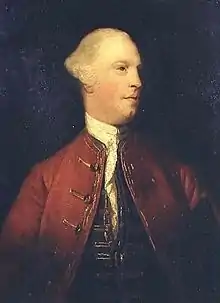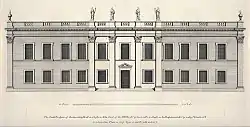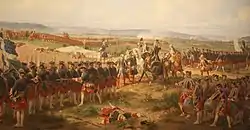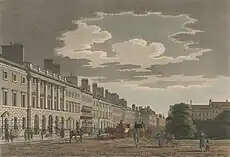James Cholmondeley | |
|---|---|
 General James Cholmondeley ca 1759-1761 by Sir Joshua Reynolds | |
| Born | 18 April 1708 Cholmondeley Hall, Cheshire |
| Died | 13 October 1775 Carrington House, Mayfair, London [1] |
| Buried | |
| Allegiance | |
| Service/ | British Army |
| Years of service | 1725-1750 |
| Rank | General 1770 |
| Unit | Colonel; 48th Foot 1741-1743 34th Foot 1743-1747 12th Lancers 1749 1st Carabiniers 1749–1750 6th (Inniskilling) Dragoons 1750–1775 |
| Commands held | Governor of Chester 1770-1775 |
| Battles/wars | War of the Austrian Succession Fontenoy 1745 Rising Falkirk |
| Relations | George, 2nd Earl of Cholmondeley, 1666-1733 (father) George, 3rd Earl of Cholmondeley, 1703-1770 (brother) George, later Marquess Cholmondeley, 1749-1827 (nephew) |
| Other work | Member of Parliament Bossiney 1731-1734 Camelford 1734-1741 Montgomery 1741-1747 |
James Cholmondeley (18 April 1708 – 13 October 1775) was a British Army officer and Member of Parliament between 1731 and 1747.
He fought at Fontenoy and during the 1745 Rising commanded a brigade at the Battle of Falkirk, where he suffered severe exposure. He retired from politics in 1747 and ceased his active military service in 1750, although promoted General in 1770.
His marriage ended in divorce in 1737 and he had no children; he died in 1775 and was buried in Westminster Abbey.
Life

James Cholmondeley was born in April 1708, third son of George, 2nd Earl of Cholmondeley (1666-1733) and Anna Elizabeth van Ruytenburgh (ca 1672–1722). His eldest brother, also named James, died young and George, Viscount Malpas (1703-1770) became heir; he had three sisters, Henrietta (1701-1769), Elizabeth (1705-1762) and Mary (1714-1783).
In 1726, he married Lady Penelope Barry (1708-1783), only child of the Earl of Barrymore and Elizabeth Savage. She was also heiress to Earl Rivers, who owned extensive estates near the Cholmondeley lands in Cheshire. The marriage was not successful and when they divorced in 1737, one of the conditions was neither would remarry; this meant that after Penelope died in 1783, the Rivers possessions passed into the Cholmondeley family.[3]
He died childless in 1775 and his property was inherited by his nephew, George, later Marquess Cholmondeley.[4]
Career

His father benefitted from backing William III in 1688 and George I in 1714, being rewarded with titles and offices, including command of the 3rd Troop of Horse Guards.[5] In April 1725, James was commissioned into his father's troop, which was normally based in London, allowing its officers to combine a military career and political office.
His elder brother George married the daughter of Sir Robert Walpole, who was Whig Prime Minister from 1721 to 1742. He held a number of government positions, although his brother-in-law Horace Walpole (1717-1797) later described him as "a vain and empty man", promoted beyond his ability by his father-in-law.[6]
This connection led to James becoming Member of Parliament for the government-controlled borough of Bossiney in 1731, then Camelford in the 1734 British general election. In 1739, commercial tensions with Spain resulted in the War of Jenkins' Ear; the military had been allowed to decay during the long period of peace since 1715 and early setbacks damaged Walpole's popularity.[7]

Cholmondeley was appointed colonel of the 48th Foot, a new regiment raised in January 1741 for the war. A few months later, he was returned as MP for Montgomery in the 1741 General Election but the government lost over 40 seats. While he continued to support the government, in February 1742 Walpole was removed from office and replaced by Earl Granville.[8]
Britain now became involved in the War of the Austrian Succession and Cholmondeley transferred to the 34th Foot in December 1742. He campaigned in Flanders from 1743 to 1745, under the Duke of Cumberland and fought at Fontenoy in May 1745. While this was an Allied defeat, his unit was part of the rearguard action that enabled their forces to retreat in good order.[9]

Promoted Brigadier-General in July, his regiment was among the reinforcements sent to Britain in November during the 1745 Rising and served in Scotland under Henry Hawley. In early January 1746, the Jacobites besieged Stirling Castle; on 13th, Hawley ordered 4,000 men under Cholmondeley and John Huske north to Falkirk to relieve it, following himself with another 3,000 men. The Battle of Falkirk began late in the afternoon of 17 January in failing light and was marked by confusion and command failures on both sides.[10] A violent snow storm broke out as the regiments deployed, making co-ordination extremely difficult; the government left was routed but Cholmondeley's brigade on the right held their ground and prevented a major Jacobite success.[11]
He fell seriously ill as a result of the extreme weather conditions and was not present with his regiment at Culloden in April. This ended his active military career, although he remained Colonel of the 6th Dragoons until his death. He was promoted general in 1770 but in the 18th century, this simply meant the holder was eligible for command; there were far more generals than positions available and many never held an active post.[12]
He retired from Parliament in 1747 and little is known of his life after this, although Dutch author Isabelle de Charrière records meeting him during her visit to London in 1766.[13] When his brother George died in 1770, he replaced him as Governor of Chester but normally resided at Carrington House, in Mayfair. He died on 13 October 1775 and was buried in Westminster Abbey, near his uncles Robert and Richard, who died in 1678 and 1680 while pupils at Westminster School.[14]
References
- ↑ Gater, G.H (ed), Wheeler, E.P (1935). 'Scotland Yard: South of Whitehall Place', in Survey of London: Volume 16, St Martin-in-The-Fields I: Charing Cross, ed. G H Gater and E P Wheeler (Online ed.). London Council.
{{cite book}}:|last1=has generic name (help)CS1 maint: multiple names: authors list (link) - ↑ "Cholmondeley family". Westminster Abbey. Retrieved 15 May 2019.
- ↑ "Papers relating to divorce of Colonel James Cholmondeley and Lady Penelope Cholmondeley (nee Barry)". National Archives. Retrieved 17 May 2019.
- ↑ Croston 1883, p. 480.
- ↑ Henderson T.F, Spain, Jonathan (2004). "Cholmondeley, George, second earl of Cholmondeley". Oxford Dictionary of National Biography (Online ed.). Oxford University Press. doi:10.1093/ref:odnb/5344.
{{cite encyclopedia}}: CS1 maint: multiple names: authors list (link) (Subscription or UK public library membership required.) - ↑ "Cholmondeley family". Elisa Rolle. Retrieved 17 May 2019.
- ↑ Avery, Emmett L, Scouten, A.H. (1968). "The Opposition to Sir Robert Walpole, 1737-1739". The English Historical Review. 83 (327): 331–336. doi:10.1093/ehr/LXXXIII.CCCXXVII.331. JSTOR 564916.
{{cite journal}}: CS1 maint: multiple names: authors list (link) - ↑ Walpole, Horace (author), Wright, John (ed) (1842). Letter to Sir Horace Mann, January 1742 in The Letters of Horace Walpole': Volume I. Lea & Blanchard. p. 214.
{{cite book}}:|last1=has generic name (help)CS1 maint: multiple names: authors list (link) - ↑ Skrine, Francis (author), Grant, James (author) (2017). Fontenoy, Britain & The War of Austrian Succession, 1740-1748, With a Short Account of the Battle of Fontenoy. LEONAUR. p. 171. ISBN 978-1782826453.
{{cite book}}:|last1=has generic name (help)CS1 maint: multiple names: authors list (link) - ↑ Royle, Trevor (2016). Culloden; Scotland's Last Battle and the Forging of the British Empire. Little, Brown. pp. 62–63. ISBN 978-1408704011.
- ↑ Edwards, HN (1925). "The Battle of Falkirk 1746". Journal of the Society for Army Historical Research. 4 (17): 129. JSTOR 44220106.
- ↑ Wood, Andrew B (2011). The Limits of Social Mobility: social origins and career patterns of British generals, 1688-1815 (PDF). PHD LSE. pp. 67–68.
- ↑ "Lettre de Zuylen" (PDF). Genootschap Belle van Zuylen. Retrieved 17 May 2019.
- ↑ "Cholmondeley family". Westminster Abbey. Retrieved 15 May 2019.
Sources
- Avery, Emmett L, Scouten, A.H. (1968). "The Opposition to Sir Robert Walpole, 1737-1739". The English Historical Review. 83 (327).
{{cite journal}}: CS1 maint: multiple names: authors list (link) - Colburn, Henry (1880). A Genealogical and Heraldic Dictionary of the Peerage and Baronetage of the British Empire. Vol. 42 pt. 1.
- Croston, James (1883). Historic sites of Lancashire and Cheshire. J. Heywood. p. 480.
- Edwards, HN (1925). "The Battle of Falkirk 1746". Journal of the Society for Army Historical Research. 4 (17).
- Henderson T.F, Spain, Jonathan (2004). Cholmondeley, George, second earl of Cholmondeley (Online ed.). Oxford DNB.
{{cite book}}: CS1 maint: multiple names: authors list (link) - Royle, Trevor (2016). Culloden; Scotland's Last Battle and the Forging of the British Empire. Little, Brown. ISBN 978-1408704011.
- Sedgwick, Romney (1970). "CHOLMONDELEY, Hon. James (1708-75)". History of Parliament Trust. Retrieved 5 December 2012.
- Skrine, Francis (author), Grant, James (author) (2017). Fontenoy, Britain & The War of Austrian Succession, 1740-1748, With a Short Account of the Battle of Fontenoy. LEONAUR. ISBN 978-1782826453.
{{cite book}}:|last1=has generic name (help)CS1 maint: multiple names: authors list (link) - Walpole, Horace (author), Wright, John (ed) (1842). Letter to Sir Horace Mann, January 1742 in The Letters of Horace Walpole': Volume I. Lea & Blanchard.
{{cite book}}:|last1=has generic name (help)CS1 maint: multiple names: authors list (link) - Wood, Andrew B (2011). The Limits of Social Mobility: social origins and career patterns of British generals, 1688-1815. PHD LSE.
External links
- "Cholmondeley family". Westminster Abbey. Retrieved 15 May 2019.
- "Papers relating to divorce of Colonel James Cholmondeley and Lady Penelope Cholmondeley (nee Barry)". National Archives.
- "Cholmondeley family". Westminster Abbey. Retrieved 15 May 2019.